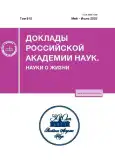STRUCTURAL MECHANISM OF IONIC CONDUCTIVITY OF THE TRPV1 CHANNEL
- Авторлар: Trofimov Y.A.1,2, Minakov A.S.3, Krylov N.A.1,4, Efremov R.G.1,4,5
-
Мекемелер:
- Shemyakin & Ovchinnikov Institute of Bioorganic Chemistry of the Russian Academy of Sciences
- National Research Nuclear University MEPhI (Moscow Engineering Physics Institute)
- Lomonosov Moscow State University
- National Research University Higher School of Economics
- Moscow Institute of Physics and Technology
- Шығарылым: Том 510, № 1 (2023)
- Беттер: 247-251
- Бөлім: Articles
- URL: https://journals.rcsi.science/2686-7389/article/view/135691
- DOI: https://doi.org/10.31857/S2686738923700221
- EDN: https://elibrary.ru/QIDHBZ
- ID: 135691
Дәйексөз келтіру
Толық мәтін
Аннотация
The so-called “hydrophobic gating” is widely discussed as a putative mechanism to control water and ion conduction via ion channels. This effect can occur in narrow areas of the channels pore lined by non-polar residues. In the closed state of the channel, such regions may spontaneously transit to a dehydrated state to block water and ions transport without full pore occlusion. In the open state, the hydrophobic gate is wide enough to provide sustainable hydration and conduction. Apparently, the transport through the open hydrophobic gate may by facilitated by some polar residues that assist polar/charged substances to overcome the energy barrier created by nonpolar environment. In this work, we investigated the behavior of Na+ ions and their hydration shells in the open pore of the rat TRPV1 ion channel by molecular dynamics simulations. We show that polar protein groups coordinate water molecules in such a way as to restore the hydration shell of ions in the hydrophobic gate that ensures ion transport through the gate in a fully hydrated state.
Негізгі сөздер
Авторлар туралы
Yu. Trofimov
Shemyakin & Ovchinnikov Institute of Bioorganic Chemistry of the Russian Academy of Sciences; National Research Nuclear University MEPhI (Moscow Engineering Physics Institute)
Хат алмасуға жауапты Автор.
Email: YuTrofimov@gmail.com
Russian Federation, Moscow; Russian Federation, Moscow
A. Minakov
Lomonosov Moscow State University
Email: YuTrofimov@gmail.com
Russian Federation, Moscow
N. Krylov
Shemyakin & Ovchinnikov Institute of Bioorganic Chemistry of the Russian Academy of Sciences; National Research University Higher School of Economics
Email: YuTrofimov@gmail.com
Russian Federation, Moscow; Russian Federation, Moscow
R. Efremov
Shemyakin & Ovchinnikov Institute of Bioorganic Chemistry of the Russian Academy of Sciences; National Research University Higher School of Economics; Moscow Institute of Physics and Technology
Email: YuTrofimov@gmail.com
Russian Federation, Moscow; Russian Federation, Moscow; Russian Federation, Dolgoprudny
Әдебиет тізімі
- Rao S., Lynch C.I., Klesse G., et al. Water and hydrophobic gates in ion channels and nanopores // Faraday Discuss. 2018. V. 209. P. 231.
- Chugunov A.O., Volynsky P.E., Krylov N.A., et al. Temperature-sensitive gating of TRPV1 channel as probed by atomistic simulations of its trans- and juxtamembrane domains // Sci. Rep. 2016. V. 6. 33112.
- Trofimov Y.A., Krylov N.A., Efremov R.G. Confined dynamics of water in transmembrane pore of TRPV1 ion channel // Int. J. Mol. Sci. 2019. V. 20. 4285.
- Zhang K., Julius D., Cheng Y. Structural snapshots of TRPV1 reveal mechanism of polymodal functionality // Cell. 2021. V. 20 (184). P. 5138.
- Benarroch E.E. TRP channels: Functions and involvement in neurologic disease // Neurology. 2008. V. 8 (70). P. 648.
- Birder L.A., Nakamura Y., Kiss S., et al. Altered urinary bladder function in mice lacking the vanilloid receptor TRPV1 // Nat. Neurosci. 2002. V. 9 (5). P. 856.
- Chuang H.H., Prescott E.D., Kong H., et al. Bradykinin and nerve growth factor release the capsaicin receptor from PtdIns(4,5)P2-mediated inhibition // Nature. 2001. V. 6840 (411). P. 957.
- Lubova K.I., Chugunov A.O., Volynsky P.E., et al. Probing temperature and capsaicin-induced activation of TRPV1 channel via computationally guided point mutations in its pore and TRP domains // Int. J. Biological Macromol. 2020. V. 158. P. 1175.
- Kasimova M., Yazici A., Yudin Y. et al. Ion channel sensing: are fluctuations the crux of the matter? // J. Phys. Chem. Lett. 2018. V. 9. P. 1260.
- Susankova K., Ettrich R., Vyklicky L., et al. Contribution of the putative inner-pore region to the gating of the transient receptor potential vanilloid subtype 1 channel (TRPV1) // J. Neurosci. 2007. V. 28 (27). P. 7578.
- Persson I. Hydrated metal ions in aqueous solution: How regular are their structures? // Pure Appl. Chem. 2010. V. 82 (10). P. 1901.
- Rao S., Klesse G., Stansfeld P.J., et al. A heuristic derived from analysis of the ion channel structural proteome permits the rapid identification of hydrophobic gates // PNAS. 2019. V. 28 (116). P. 13989.
- Beckstein O., Sansom M.S.P. A hydrophobic gate in an ion channel: The closed state of the nicotinic acetylcholine receptor // Physical Biology. 2006. V. 2 (3). P. 147.
- Yonkunas M., Kurnikova M. The hydrophobic effect contributes to the closed state of a simplified ion channel through a conserved hydrophobic patch at the pore-helix crossing // Front. Pharmacol. 2015. V. 6. P. 284.
- Hess B., Kutzner C., Spoel D.V.D. GROMACS 4: algorithms for highly efficient, load-balanced, and scalable molecular simulation // J. Chem. Theory and Computation. 2008. V. 3 (4). P. 435.
- Lindorff-Larsen K., Piana S., Palmo K., et al. Improved side-chain torsion potentials for the Amber ff99SB protein force field // Proteins: Structure, Function and Bioinformatics. 2010. V. 8 (78). P. 1950.
- Jorgensen W.L., Chandrasekhar J., Madura J.D., et al. Comparison of simple potential functions for simulating liquid water // J. Chem. Phys. 1983. V. 2 (79). P. 926.
- Joung I.S., Cheatham T.E. Determination of alkali and halide monovalent ion parameters for use in explicitly solvated biomolecular simulations // J. Phys. Chem. B. 2008. V. 30 (112). P. 9020.












